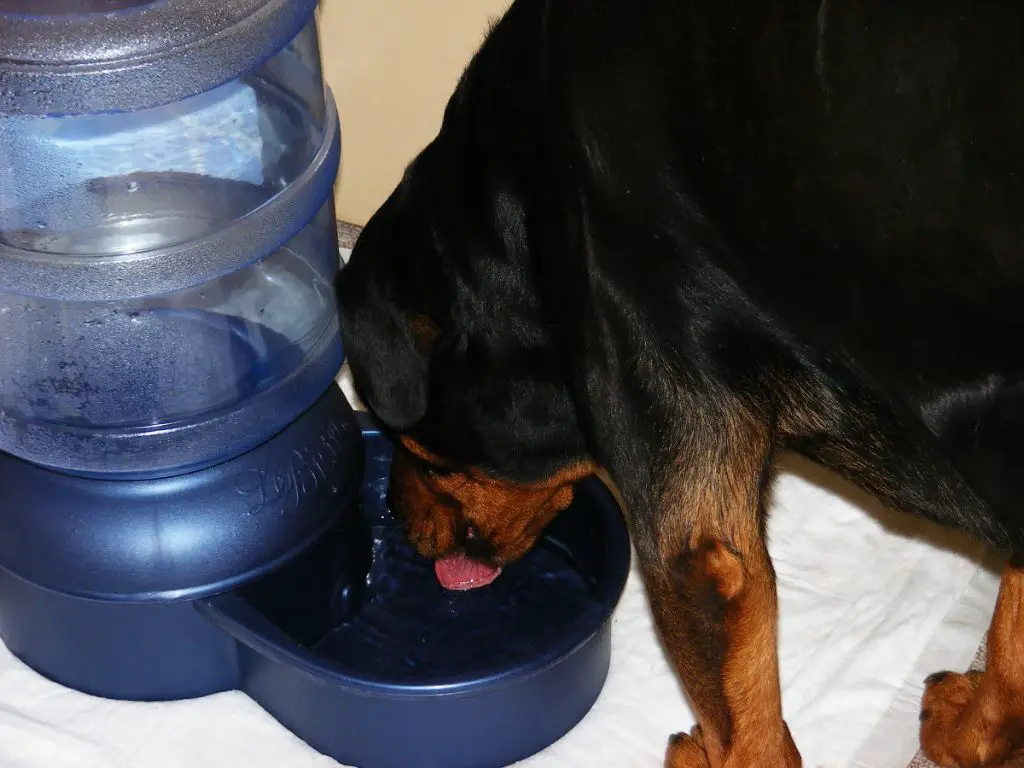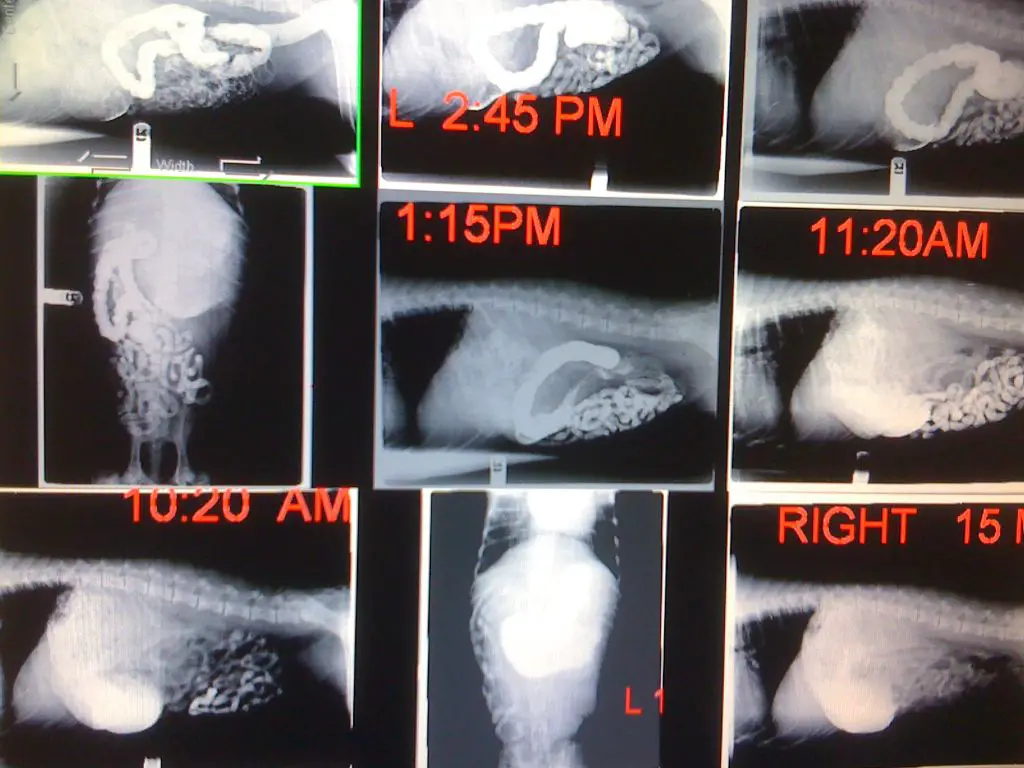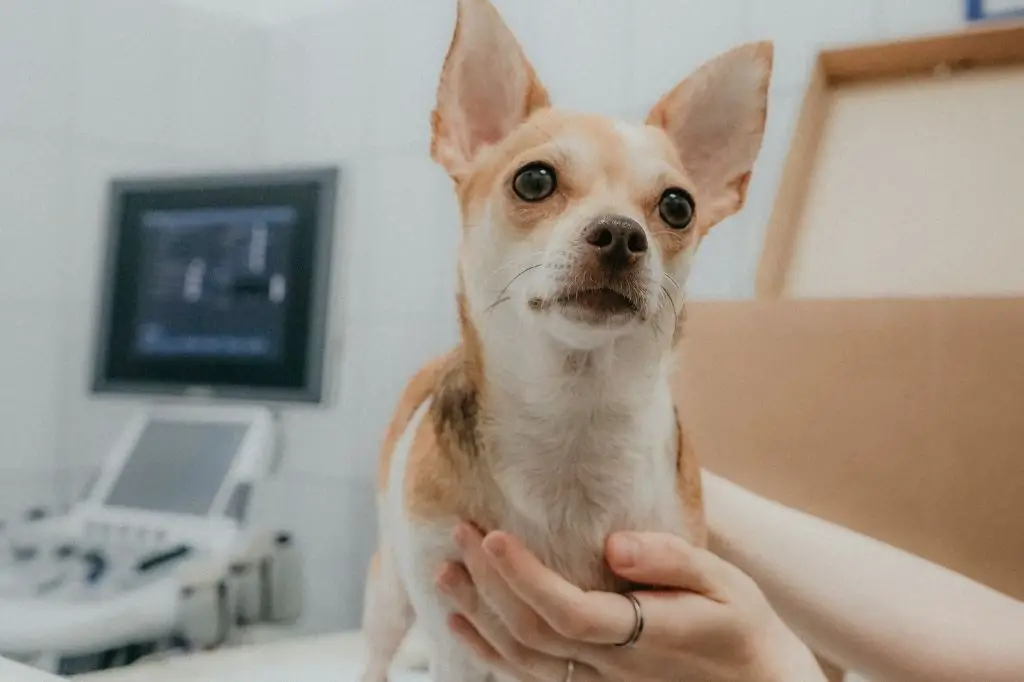What is a Barium Study?
A barium study, also known as a barium swallow study, is a radiographic imaging procedure used to examine a dog’s gastrointestinal tract. It involves giving the dog barium sulfate, which shows up on x-rays, and taking a series of x-rays as the barium moves through the esophagus, stomach, and intestines.
The main purpose of a barium study is to identify abnormalities in the gastrointestinal tract such as obstructions, motility disorders, ulcers, masses, and hernias. It allows the veterinarian to visualize the shape and function of the structures in the digestive system.
During a barium study, x-rays are taken of the dog’s chest, abdomen, and sometimes the esophagus. This allows the veterinarian to see the flow of barium through the pharynx, esophagus, stomach, small intestine, and large intestine.
Why Do Dogs Get Barium Studies?
Barium studies are commonly ordered by veterinarians to investigate issues like vomiting, diarrhea, and difficulty swallowing in dogs. Some of the main medical reasons dogs undergo this procedure include:
- Gastrointestinal issues – Barium enhances x-ray contrast and allows vets to get clear images of the esophagus, stomach, and intestines. This helps identify conditions like ulcers, tumors, blockages, and motility disorders.
- Swallowing difficulties – Barium studies help evaluate dysphagia and problems swallowing food or water. The barium outlines the esophagus and reveals obstructions.
- Vomiting and diarrhea – Imaging the GI tract with barium can uncover causes of chronic vomiting and diarrhea like irritable bowel disease, infections, and intestinal blockages.
- Foreign body detection – Barium sticks to foreign objects like bones, rocks, or fabric lodged in the digestive system and makes them clearly visible on x-rays.
- Hiatal hernias – Barium studies can reveal hiatal hernias, where part of the stomach protrudes into the chest through the diaphragm.
- Leak detection – Barium may be used after surgery on parts of the digestive tract to check for leaks at surgical sites.
In short, barium imaging allows vets to get clear views of the esophagus, stomach, and intestines, helping diagnose many conditions causing vomiting, diarrhea, swallowing issues, blockages, and more in dogs.
How Barium Studies Work

When performing a barium study in dogs, the veterinarian will utilize a contrast medium called barium sulfate.
This white, chalky liquid shows up on x-rays or fluoroscopy and is given to the dog to ingest.
As the dog drinks the barium, it coats the lining of the esophagus, stomach, and intestines. This allows the radiologist to view the outlines and motility of these structures on imaging during the procedure.
Over the course of the barium study, x-rays or fluoroscopy videos are taken as the barium sulfate travels through the GI tract. This enables visualization of the digestive system and can help identify any abnormalities or disruptions in function.
The barium sulfate will also highlight any GI obstructions, masses, ulcers, hernias, or other problems as it passes through the dog’s system.
Once the barium study images are complete, the veterinary team will be able to analyze the stomach, intestine, and colon function and anatomy. The contrast of the barium on the radiographs is a useful diagnostic tool for investigating GI issues in dogs.
What to Expect During the Procedure
A barium study is a relatively simple procedure that does not require anesthesia. Here is what you can expect during your dog’s barium study:
Your dog will be given a liquid barium solution to drink. Barium is a contrast agent that shows up on x-rays. The veterinarian will give specific instructions on how much barium your dog needs to consume. It is important that your dog drinks all of the barium for clear x-ray results.
Once your dog has finished the barium, the technician will begin taking a series of x-rays. Your dog will need to stand still during each x-ray. The technician may gently restrain your dog to prevent movement and retake x-rays if needed. Your dog may be placed in different positions to get views of the stomach, intestines, or other areas being examined.

You can comfort your dog with calm praise and petting during the procedure. But it is important that your dog holds still for the x-rays, so the images come out clear. The number of x-rays taken will vary depending on the area being examined. But the technician will work quickly to get all the needed images.
Some clinics will have you wait with your dog during the x-rays. At others, they may ask you to step out of the room and return once the images are complete. This protects you from repeated radiation exposure.
Duration of Barium Study
A barium study is usually a relatively quick procedure taking 30 minutes to an hour to complete from start to finish. Here is a breakdown of the timeline:
Preparation and Barium Administration: Your vet will first prepare your dog for the procedure by likely having you withhold food for 12 hours. Upon arrival at the vet, they will administer oral barium for your dog to drink. This barium prep generally takes around 15-30 minutes as the dog must fully drink and coat their GI tract.
X-Ray Series: Once barium is administered, your dog will be taken for a series of x-rays. They will have to stand still and hold positions as images are captured. The actual imaging typically takes 15-30 minutes depending on the number of views needed. Most studies require 6-12 x-ray images.
Overall, you can expect the full process from start to finish, including check-in, barium prep, imaging, and discharge to take approximately 30 minutes to 1 hour. The actual hands-on procedures of prepping and imaging generally total 30-45 minutes. Factors like your dog’s cooperation and the number of x-rays needed can affect the duration.
Factors Affecting Duration
The duration of a barium study can vary depending on several factors, primarily related to the dog and the issues being investigated.
One key factor is the dog’s cooperation and ability to drink and hold the barium. Some dogs may struggle to consume all of the barium solution or may regurgitate it before the x-rays can be taken. This can prolong the procedure as more barium may need to be given. Very anxious or uncooperative dogs may need sedation, which also lengthens the process.
The issues being investigated and whether extra x-rays are needed also impacts duration. If the vet needs detailed views of a particular area, additional x-rays from different angles may be required, extending the procedure time. More complex issues like exploring multiple areas of the digestive tract or looking for subtle abnormalities means more images and therefore a longer barium study.
Overall, most routine barium studies take 15-30 minutes from start to finish. But in less cooperative dogs or those with complicated issues, the procedure may take 45 minutes to over an hour. Knowing the factors that can affect duration helps owners understand why their dog’s barium study may be shorter or longer than average.
Aftercare and Recovery

After a barium study, your dog will need some care while recovering back to normal.
Once the procedure is complete, your vet may recommend slowly easing your dog back onto their normal diet and routine. This is because the barium can sometimes cause constipation as it works its way fully out of the digestive tract. Feed smaller meals of the dog’s regular food at first, while monitoring their bowel movements for signs of straining or discomfort.
Make sure your dog has access to plenty of fresh water to help flush the barium out of their system. You may want to add some canned pumpkin or fiber supplements to their meals to aid this process. Limit excessive exercise and activity during the first 24 hours to allow the barium to pass through.
Contact your vet if your dog shows signs of bloating, vomiting, or failure to pass stool after the procedure. Most dogs will pass the barium within 24-48 hours with no issues. Once your dog has resumed normal bowel movements, you can return to their regular diet and exercise routine.
Overall, with proper monitoring and care during recovery, dogs do very well after a barium study. Just focus on restoring normal digestion and watch for any concerning symptoms. Within a day or two, your pup should be back to their old self.
Risks and Contraindications
A barium study is generally considered a very safe procedure for dogs, but as with any medical test there are some potential risks and contraindications to be aware of:
Barium aspiration – In rare cases, the barium can be accidentally inhaled into the lungs during swallowing or vomiting. This can cause aspiration pneumonia. The risk is low with proper patient handling during the procedure.
GI obstruction – A barium study should not be performed on dogs with a known blockage or obstruction in their esophagus or GI tract, as introducing barium could worsen the obstruction.
Allergic reaction – Some dogs may have an allergic reaction to the barium sulfate powder. Reactions are usually mild if they occur.
Radiation – As in all diagnostic imaging using x-rays, there is a small degree of risk from repeated or prolonged radiation exposure. Veterinarians will take precautions to minimize radiation doses during the procedure.
As with any procedure requiring anesthesia, dogs with significant health issues or respiratory problems may have higher risks from anesthesia required for a barium study. Veterinarians will assess risks vs benefits for the individual patient.
Cost of Barium Studies
Like any veterinary medical procedure, the cost of a barium study can vary quite a bit depending on where you live and which vet you use. However, some average costs include:

- Radiology time – The radiologist doing the imaging and interpreting the results may charge anywhere from $100-300 for their time.
- Supplies – This includes the barium paste/liquid, materials for giving it orally or via enema, any sedatives or anesthesia, etc. Supplies usually range from $50-150.
- The procedure fee – Your vet may charge an additional fee just for doing the barium series, which is typically $200-400.
When you add up all these costs, the total for a barium study often ranges from $350-850, with most pet owners reporting total bills of $450-600. This is just an average across the country. Your actual costs could be higher or lower depending on your location, vet clinic, if anesthesia is needed, and whether any complications occur.
Summary
To recap, a typical barium study for dogs takes anywhere from 30 minutes to 2 hours from start to finish. The procedure begins with the veterinarian or technician positioning the dog and administering the oral contrast, which usually takes about 5-15 minutes. Once the contrast is given, the dog waits 30-60 minutes for it to move through the digestive tract before the X-rays are taken, which takes another 5-10 minutes. Some vets will take multiple X-rays over the course of an hour or two to view the contrast passing through the different areas of the GI tract. Aftercare like monitoring the dog for any vomiting or diarrhea from the contrast can extend the overall timeframe to 2 hours.
In summary, most barium studies for dogs take about 1 hour on average, with 30 minutes on the shorter end and 2 hours on the longer end, depending on the specific purpose of the study and how many X-rays and images the vet needs. The key steps of administration, waiting, imaging, and monitoring generally unfold over the course of an hour or two from start to finish in a smooth and efficient veterinary process.